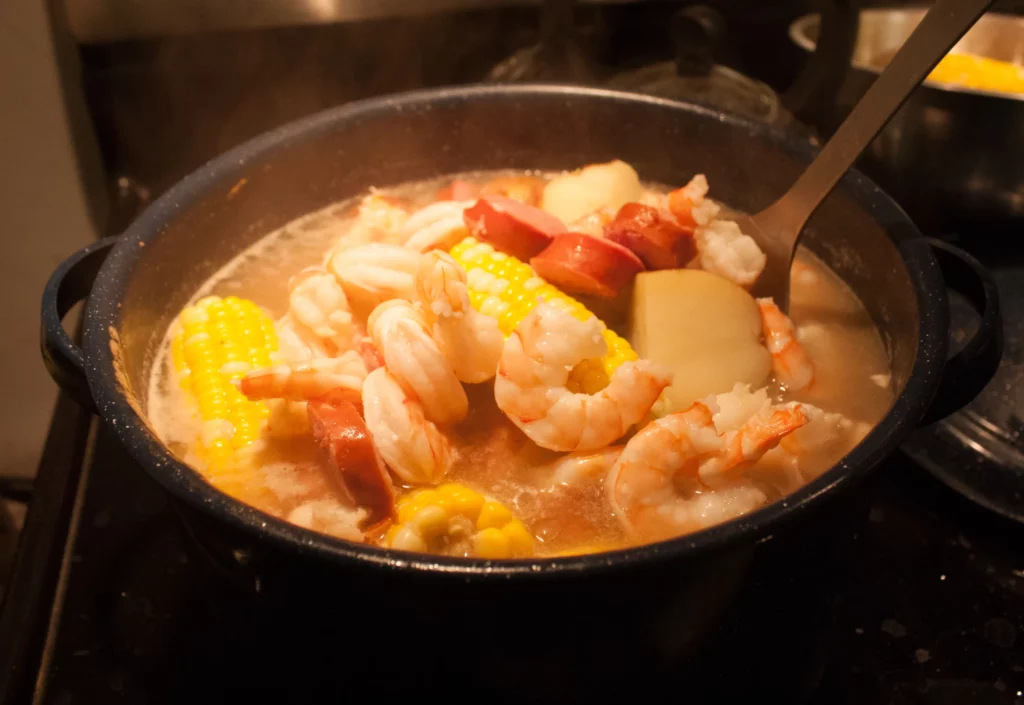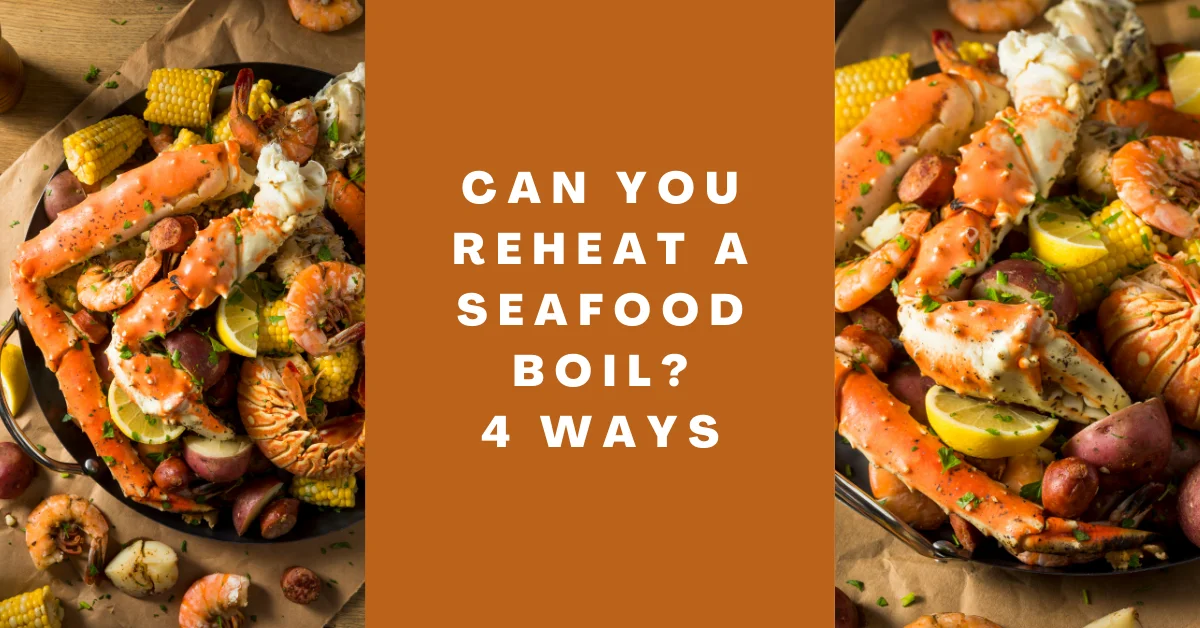A seafood boil is loved by many and widely consumed worldwide. It is such a fulfilling meal! In fact, with a seafood boil, you may be left with plenty of leftovers. This is why most seafood boil lovers tend to question, can you reheat a seafood boil?
In this article, we will discuss everything regarding reheating a seafood boil! Let’s get to it!
Yes, you can reheat a seafood boil easily. Using an oven is your best bet, but there are several other methods of reheating a seafood boil. You can use a microwave, oven, pressure cooker, or stovetop. Always remember that low temperatures are ideal for reheating a seafood boil.
Can you eat a seafood boil the next day?
Yes, you can consume seafood boil the next day by simply reheating it. You can reheat a seafood boil for the next 4 days after being prepared. However, you need to make sure that you use low temperatures for reheating, or else your seafood boil might end up ruined.
Just make sure that you have not left your seafood boil at room temperature for more than 2 hours, or else it will go bad and become unsafe for eating. Refrigerate it to slow down bacterial growth.
How do you reheat leftover seafood boil?
These 4 effective methods for reheating a seafood boil. We have briefly discussed all of them below to ease things for you!

Reheat a seafood boil in the oven
This is a great way of reheating a seafood boil as it doesn’t make any mess. You can efficiently reheat a seafood boil in the oven, within less time and with much less hard work. Here’s what you need to do to reheat a seafood boil in the oven:
- Grab either a baking dish or casserole dish along with aluminum foil.
- Preheat the oven to 275 degrees Fahrenheit.
- Sparsely grease the casserole or baking dish, and then put your seafood boil into it. Make sure to splash a little bit of water on it.
- Now cover the entire dish with aluminum foil; this will prevent the seafood boil edges from drying out until the middle part is completely heated. Moreover, this will protect your oven from the awful smell of seafood boil.
- Place the dish into the oven and let it reheat for 10 to 15 minutes. You can examine the internal temperature; once it reaches between 125-130 degrees Fahrenheit, you should know your seafood boil has been reheated!
If you want to learn more about reheating foods in an oven, have a look at our articles on heating up noodles and fufu!
Reheat a seafood boil in the microwave
You can reheat a seafood boil in the microwave as it is a very quick method, but it can fail to produce the best results. Moreover, the microwave might end up overcooking some vegetables and meat, or you might have a few cold spots due to uneven microwave heating. Here’s what you need to do to reheat a seafood boil in the microwave:
- Place the seafood boil bag in a microwave-safe bowl and pop it in the microwave.
- Microwave the seafood boil on high for around 7 minutes.

Reheat a seafood boil on the stove
This is the best possible way of reheating your leftover seafood boil. Using a stove lets you reheat your seafood boil within ten minutes without making any mess! Here’s what you need to do to reheat a seafood boil on the stove:
- Grab a large bowl/pot and add some water to it for boiling.
Tip: Fill the pot halfway for best results.
- Place the boil bag that contains your seafood boil in the boiling water.
- In case your seafood boil isn’t in the boil bag, make sure to transfer it to a boil bag before dunning it in the boiling water.
- Let the boil bag heat for around 10 minutes, or until you spot steam within the boil bag; this steam will show you that the contents of the boil bag are heated well.
Tip: Carefully take out the boil bag once 5-8 minutes have passed to shake its contents. This will ensure even heating over the seafood boil.
- Once the seafood boil has been reheated sufficiently, take out the boil bag and let it cool down for 10 minutes on a cooling rack before serving.
Continue reading about reheating seafood by checking out our guide on how to reheat shrimp!

Related FAQs to a seafood boil!
Can you reheat a seafood boil in the pressure cooker?
Yes, you can use a pressure cooker to reheat a seafood boil. However, with a pressure cooker, you need to be extra mindful about the duration of reheating. Plus, make sure that the boil bag remains submerged in the pressure all the time.
In some cases, the boil bag can burst due to high temperatures and extreme pressure. Therefore, it is always recommended to spare 10-20 minutes extra for reheating a seafood boil instead of risking the entire dish.
What can I do with leftover seafood boil broth?
Seafood boil broth is extremely flavorful. You can use it in various dishes for an extra boost of flavors. For instance, you can dip okra in leftover seafood boil broth or create a savory pan sauce with it. You can also use the leftover seafood boil broth for boiling rice and potatoes and making soup.
How to store seafood boil?
You can store your leftover seafood boil in a re-sealable plastic bag or a huge plastic container with a lid. Whichever container you use, just store the seafood boil in the refrigerator, making sure that it is covered.

How long does boiled seafood last in the fridge?
A seafood boil can easily last for 3-4 days in the fridge if stored properly. Refrigeration slows down the bacterial infestation. However, it doesn’t completely prevent bacterial growth on food items. Hence, it is advised to consume the stored seafood boil within 3-4 days before it turns bad and makes you sick.
Can you reboil seafood boil?
Yes, you can reboil a seafood boil. However, it is not recommended to do so. This is because rebuilding a seafood boil will ruin flavors and texture. Instead of reboiling, you can simply reheat a seafood boil in the oven, microwave, or using a stovetop.
How do you reheat boiled crab?
- Preheat your oven to 350 degrees Fahrenheit.
- Grab a huge glass dish and fill it with ½ inches of water. Then place the crab in it.
- Cover the dish with foil completely, and poke some holes to allow the steam to escape.
- Pop the dish into the preheated oven for 15 minutes if thawed and 25 minutes if frozen.
Also read our article on how you can reheat crawfish in this guide!
Wrapping up our thoughts on reheating seafood boil!
You might likely end up with leftovers as a seafood boil can be heavy on the stomach. Reheating the leftover seafood boil is a great way to consume it if you don’t wish to use it for other recipes.
Simply reheat your seafood boil using any of the 4 methods mentioned above and enjoy the variety of flavors once again!



